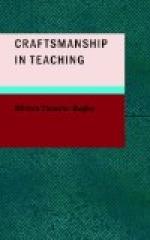And so the great men of history, from the very fact of their genius, are apt not to correspond with what our ideal of greatness demands. Indeed, our ideal is often more nearly realized in men who fall far short of genius. When I studied chemistry, the instructor burned a bit of diamond to prove to us that the diamond was, after all, only carbon in an “allotropic” form. There seems to be a similar allotropy working in human nature. Some men seem to have all the constituents of genius, but they never reach very far above the plane of the commonplace. They are like the diamond,—except that they are more like the charcoal.
I wish to describe to you a teacher who was not a genius, and yet who possessed certain qualities that I should abstract and appropriate if I were to construct in my imagination an ideal teacher. I first met this man five years ago out in the mountain country. I can recall the occasion with the most vivid distinctness. It was a sparkling morning, in middle May. The valley was just beginning to green a little under the influence of the lengthening days, but on the surrounding mountains the snow line still hung low. I had just settled down to my morning’s work when word was brought that a visitor wished to see me, and a moment later he was shown into the office. He was tall and straight, with square shoulders and a deep chest. His hair was gray, and a rather long white beard added to the effect of age, but detracted not an iota from the evidences of strength and vigor. He had the look of a Westerner,—of a man who had lived much of his life in the open. There was a ruggedness about him, a sturdy strength that told of many a day’s toil along the trail, and many a night’s sleep under the stars.
In a few words he stated the purpose of his visit. He simply wished to do what half a hundred others in the course of the year had entered that office for the purpose of doing. He wished to enroll as a student in the college and to prepare himself for a teacher. This was not ordinarily a startling request, but hitherto it had been made only by those who were just starting out on the highroad of life. Here was a man advanced in years. He told me that he was sixty-five, and sixty-five in that country meant old age; for the region had but recently been settled, and most of the people were either young or middle-aged. The only old men in the country were the few surviving pioneers,—men who had come in away back in the early days of the mining




